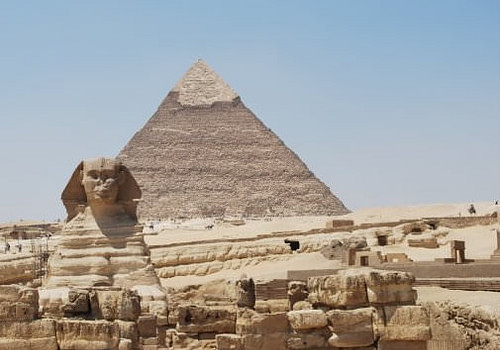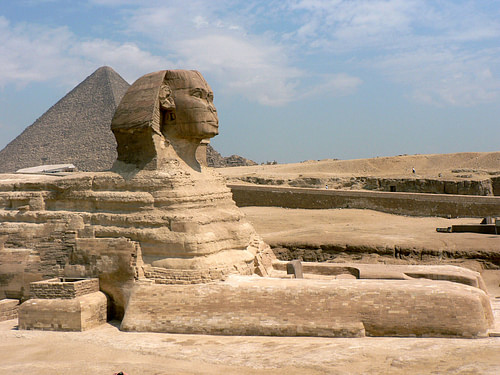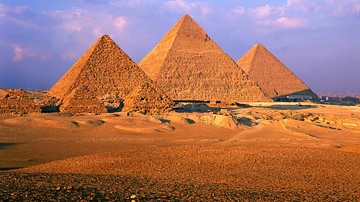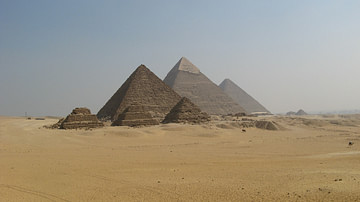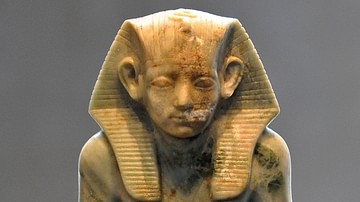Buried for most of its life in the desert sand, an air of mystery has always surrounded the Great Sphinx, causing speculation about its age and purpose, method of construction, concealed chambers, role in prophecy, and relationship to the equally mysterious pyramids. Much of this theorizing is to the despair of Egyptologists and archaeologists, who, reasonably it seems to me; only give credence to theories that are backed up by tangible evidence.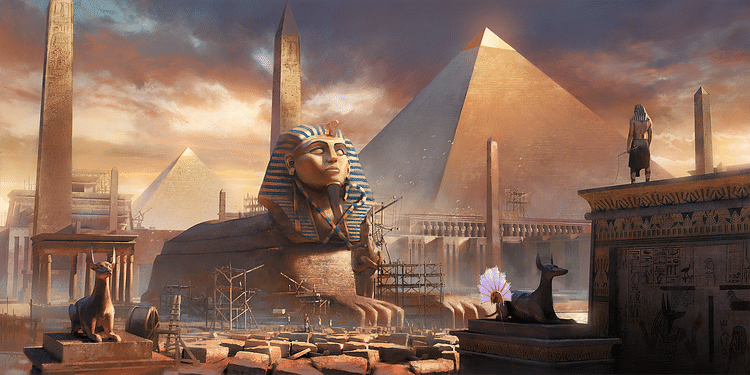
The Mystery of the Great Sphinx
Facing the rising sun, the Great Sphinx is located on the Giza plateau, about 10 km west of Cairo, on the west bank of the Nile River. Later Egyptian rulers worshipped it as an aspect of the sun god, calling it Hor-Em-Akhet (“Horus of the Horizon”). The Sphinx sits in part of the necropolis of ancient Memphis, the seat of power for the pharaohs, a short distance from three large pyramids – the Great Pyramid of Khufu (Cheops), Khafre (Chephren) and Menkaura (Mycerinus).
The monument is the largest surviving sculpture from the ancient world, measuring 73.5 m in length and in parts 20 m in height. Part of the uraeus (sacred cobra which protected from evil forces), the nose and the ritual beard are missing; the beard is now displayed in the British Museum. The extensions at the side of the head are part of the royal headcloth. Although the head of the Sphinx has been badly affected by thousands of years of erosion, traces of the original paint can still be seen near one ear. It is thought that originally the Sphinx's face was painted dark red. A small temple between its paws contained dozens of inscribed stelae placed by the Pharaohs in honour of the Sun god.
The Pharaoh's Dream
The Sphinx has suffered greatly from the ravages of time, man and modern pollution. In fact, what has saved it from complete destruction is the fact that it has been submerged beneath the desert sand for most of its life. There have been various attempts to restore the Great Sphinx over the millennia, beginning in c. 1400 BCE with the pharaoh Tuthmosis IV. After falling asleep in the shade of the Sphinx when out hunting, the pharaoh dreamt that the great beast was choking from the sand engulfing it, and that it told him if he cleared the sand he would obtain the crown of Upper and Lower Egypt. In between the front paws of the Sphinx is a granite stela, now called the “Dream Stela”, which is inscribed with the story of the pharaoh's dream.
Towards the end of 2010 CE, during routine excavation work in the area of the monument, Egyptian archaeologists discovered large sections of mudbrick walls which were part of a larger wall which stretched for 132 meters (433 feet) around the Great Sphinx. The archaeologists believe that the wall was built by Tuthmosis IV after his dream to protect the Sphinx from the desert winds.
After the clearing ordered by Tuthmosis IV, and despite the wall, the colossal sculpture once again found itself beneath the sand. When Napoleon arrived in Egypt in 1798 CE, he found the Sphinx without its nose. 18th century CE drawings reveal that the nose was missing long before Napoleon's arrival; one story goes that it was the victim of target practice in the Turkish period. Another and perhaps the most likely explanation, is that it was pried off by chisels in the 8th century CE, by a Sufi who considered the Sphinx a sacrilegious idol. In 1858 CE, some of the sand around the sculpture was cleared by Auguste Mariette, the founder of the Egyptian Antiquities Service, and between 1925 and 1936 CE, French engineer Emile Baraize excavated the Sphinx on behalf of the Antiquities Service. Possibly for the first time since antiquity, the Great Sphinx was once again exposed to the elements.
Who does the Great Sphinx Depict?
The explanation for the enigmatic sculpture favoured by most Egyptologists is that Chephren, a Fourth Dynasty pharaoh, had the stone shaped into a lion with his own face at the same time as the construction of the nearby Pyramid of Chephren, around 2540 BCE. However, there are no inscriptions anywhere that identify Chephren with the Sphinx, neither is there mention anywhere of its construction, which is somewhat puzzling when considering the grandness of the monument. Despite many Egyptologists' claims to the contrary no-one knows for sure when the Sphinx was built or by whom.
In 1996 CE, a New York detective and expert in identification concluded that the visage of the Great sphinx did not match known representations of Chephren's face. He maintained that there was a greater resemblance to Chephren's elder brother Djedefre. The debate is still continuing. The mystery of the Sphinx's origin and purpose has often given rise to mystical interpretations, such as those of English occultist Paul Brunton and, in the 1940's CE, controversial American psychic and prophet Edgar Cayce.
The Great Sphinx was excavated from a relatively soft, natural limestone, left over in the quarry used to build the Pyramids; the forepaws being separately made from blocks of limestone.
One of the main oddities about the sculpture is that the head is out of proportion to its body. It could be that the head was re-carved several times by subsequent pharaohs since the first visage was created, though on stylistic grounds this is unlikely to have been done after the Old Kingdom period in Egypt (ending around 2181 BC). Perhaps the original head was that of a ram or hawk and was recut into a human shape later. Various repairs to the damaged head over thousands of years might have reduced or altered the facial proportions. Any of these explanations could account for the small size of the head in relation to the body, particularly if the Great Sphinx is older than traditionally believed.
The Dating of the Great Sphinx
There has been lively debate in recent years over the dating of the monument. Author John Anthony West first noticed weathering patterns on the Sphinx that were consistent with water erosion rather than wind and sand erosion. These patterns seemed peculiar to the Sphinx and were not found on other structures on the plateau. West called in Geologist and Boston University professor Robert Schoch, who, after examining the new findings, agreed that there was evidence for water erosion.
Although Egypt is arid today, around 10,000 years ago the land was wet and rainy. Consequently West and Schoch concluded that in order to have the effects of water erosion they found, the Sphinx would have to be between 7,000 and 10,000 years old. Egyptologist's dismissed Schoch's theory as highly flawed; pointing out that the once prevalent great rain storms over Egypt had stopped long before the Sphinx was built. More seriously, why were there no other signs of water erosion found on the Giza plateau to validate West and Schoch's theory? The rain could not have been restricted to this single monument. West and Schoch have also been criticised for ignoring the high level of local atmospheric industrial pollution over the last century, which have severely damaged the Giza monuments.
Someone else with his own theory behind the Sphinx's date is author Robert Bauval. Bauval published a paper in 1989 CE showing that the three Great Pyramids at Giza, and their relative position to the Nile, formed a kind of 3-D 'hologram' on the ground, of the three stars of Orion's belt and their relative position to the Milky Way.
Along with Fingerprints of the Gods author Graham Hancock, Bauval developed an elaborate theory that the Sphinx, its neighbouring pyramids and various ancient writings, constitute some sort of astronomical map connected with the constellation Orion. Their conclusion is that the best fit for this hypothetical map is the position of the stars in 10,500 BCE, so pushing the origin of the Sphinx even further back in time. This date is understandably disputed by Egyptologists, as not a single archaeological artefact dated to that period has ever been discovered in the area.
Secret Passageways?
There are various legends of secret passages associated with the Great Sphinx. Investigations by Florida State University, Waseda University in Japan, and Boston University, have located various anomalies in the area around the monument, although these could be natural features. In 1995 CE, workers renovating a nearby parking lot uncovered a series of tunnels and pathways, two of which plunge further underground close to the Sphinx. Robert Bauval believes these are contemporaneous with the Sphinx itself. Between 1991 and 1993 CE, while examining evidence for erosion at the monument using a seismograph, Anthony West's team found evidence of anomalies in the form of hollow, regularly shaped spaces or chambers, a few metres below the ground, between the paws and at either side of the Sphinx. No further examination has been allowed.
Today, the great statue is crumbling because of wind, humidity and the smog from Cairo. A huge and costly restoration and preservation project has been underway since 1950 CE, but in the early days of this project cement was used for repairs which was incompatible with the limestone, and so caused additional damage to the structure. Over a period of 6 years over 2,000 limestone blocks were added to the structure and chemicals were injected into it, but the treatment failed. By 1988 CE the sphinx's left shoulder was in such a state of deterioration that blocks were falling off. At present restoration is still an ongoing project under the control of the Supreme Council of Antiquities, who are making repairs to the damaged shoulder and attempting to drain away some of the subsoil. Consequently, today the focus is on preservation rather than further explorations or excavations, so we will have to wait a long time yet before the Great Sphinx gives up her secrets.
